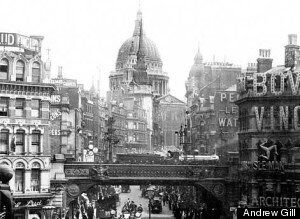In 1961, when I was eleven years old, my father bought a rusty, tin magic lantern and a box of glass slides from a junk shop and I can still recall the excitement of giving my first show to friends. What fun we had, 'though in hindsight, perhaps the fun was all mine! The magic lantern was the forerunner of the pre-digital, 35mm slide projector which, you may recall (if you're of a certain age), was a device used in the late 20th century to inflict our holiday photos on our friends and neighbours.
The first magic lanterns were made in the early 17th century by natural philosophers, early scientists, who were exploring the nature and commercial potential of optics and, no doubt, looking for a way to show their latest travel etchings. It consisted of a box containing a light source, lenses to focus the image and a slot for inserting transparent slides. As light sources and lenses improved, it was possible to show bigger, brighter and clearer pictures to ever larger audiences and during Queen Victoria's reign, magic lantern shows were as popular as cinema would be one hundred years later. Shows could be lavish, theatrical events with all the razzmatazz of today's TV talent contests, using triple lanterns to produce special effects or a simple family-night-in, using a low-cost, tin magic lantern to amuse the kids.
Even in the early 18th century, almost two hundred years before the first cinemas opened, slides were produced with one piece of glass that slipped in front of another, giving an illusion of movement and by the mid 1800s these had developed into beautiful kaleidoscopes, children skipping, dentists pulling teeth and a man swallowing rats as he sleeps with his mouth open... still a favourite with children today! At the white-knuckle end of the market, magic lanterns were used to create phantasmagoria horror shows where terrifying devils, witches and the grim reaper were conjured out of thin air, with accompanying sound effects in suitably scary venues.
Once a process had been invented for applying photographs to slides, the magic lantern industry boomed and in its heyday, the 1890s, millions of slides were produced, particularly in Britain, France and America, for entertainment, amusement, education, spiritual enlightenment, moral crusades and titillation.
The first movie film was made by the Lumiere brothers in 1895 and, from that moment, the demise of the magic lantern was inevitable but it was a very slow death. It was considered to be old-fashioned by the start of the First World War but slides continued to be produced commercially during the 1920s and 30s and by amateur photographers into the 1950s. Ironically, cinemas, the cause of the magic lantern's downfall, used lantern slides for advertisements and forthcoming attraction notices as late as the 1960s.
Having had my appetite whetted in my formative years, I started collecting magic lanterns and slides in my mid twenties and, since then, I've purchased a quarter of a million slides. Clearly, this is way beyond a normal collector's passion and is worthy of a medical study of some sort. However, I'm not alone; there are other enthusiasts out there, many of whom are members of the Magic Lantern Society.
A few years ago, as interest in local history and genealogy was growing, I realised that I had acquired a collection of exceptional, social-history related photographs and we formed a family business, the Keasbury-Gordon Photograph Archive, to sell photographs reproduced from our original slides via an Ebay store.


Perhaps surprisingly, interest in our Victorian magic lantern shows is also growing. We present these at festivals, museums, galleries and special interest group meetings using an original mahogany and brass magic lantern and glass slides up to 170 years old. Queen Victoria has been quoted as saying that she was not amused but her subjects certainly were and many of the slides we show tell comical, often wacky, stories. We can move an audience to tears with Victorian melodramas and ballads and make them gasp at hand-painted and animated slides. We show photographs of how we lived a hundred years ago and include Victorian songs that are still familiar today, illustrated by enchanting slides. Who would imagine that in this high-speed, three-second-image, digital age, you can have so much fun with a slide projector!
Of course many people collect antiques, which then gather dust until Dad (rarely Mum) pops off and the kids then sell his old junk as soon as they can decently do so. My children may, of course, do the same but I like to think that, two hundred years from now, someone, somewhere, will be using my magic lantern and slides to delight, surprise and thrill audiences, just as showmen have been doing for the last three hundred and fifty years.
Contact: lanternist@ntlworld.com